The Perseid meteor shower — one of the largest known annual meteor showers — will be visible across the globe this weekend. Local spectators can visit the MSU Observatory on the night of Aug. 12 - 13 to watch the event.
The Perseids
According to Physics and Astronomy Professor and Abrams Planetarium Manager Shannon Schmoll, the meteors are part of a debris field from the Swift-Tuttle comet. The comet, which last passed by earth in 1992, orbits around the sun every 133 years. Each year, the debris from the comet collides with earth to create a month-long meteor shower, which is most visible in the northern hemisphere.
When debris enters the atmosphere, friction in the air causes the meteoroids to heat up and burn. The gases surrounding the particles also burn, creating streaks of light in the sky. During the Perseids shower, the streaks appear to be radiating out of the Perseus constellation, hence the name of the shower, Schmoll said.
“If we were to sort of take the paths of all the meteors we see and trace them back, it looks like they're radiating out of a point in the constellation Perseus,” Schmoll said. “But really, you can see them at any point anywhere in the sky, so just looking up is what you need to do.”
This year’s shower
Though the shower has already started, this Saturday night, Aug. 12, will be the best opportunity to view the event because earth will be passing through the densest part of the debris field. Additionally, there are heightened expectations for this year’s shower because the waning crescent moon won’t rise until almost 4 a.m., making the sky especially dark.
During that night, the Zenith Hourly Rate, or ZHR, which measures how many meteors viewers can see each hour, will be approximately 100. Schmoll said this number is higher than what will actually be visible because of light pollution and the amount of sky that viewers can see. If the sky is clear, viewers will be able to see a meteor every few minutes, Schmoll said.
How to watch the Perseids
For the best view of the show, Schmoll said spectators should go to an area with low light pollution in the hours between midnight and the moonrise. Telescopes and binoculars are not necessary, and they may actually be obstructive since they decrease a person’s field of view, Schmoll said.
Spectators can also watch the shower from the the MSU Observatory, which is hosting a free public viewing night from 9 to 11 p.m. Because the observatory has less light pollution and more open space, attendees may be able to see more meteors. Additionally, people will have the opportunity to talk with astronomers and look through telescopes.
“As long as you're away from the city lights, you should expect to see around a meteor every few minutes,” Schmoll said. “That would be visible easily. You might not catch everyone, so it might be more than every few minutes, but right now this is a fairly good showing. So if you're out there, find a cozy spot away from city lights, a warm blanket, maybe some hot cocoa and just look up at the sky and you'll you'll see those meteors passing overhead.”




